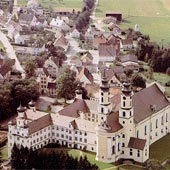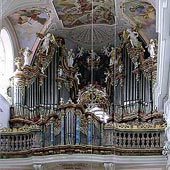Pipedreams Euro-Tour
April 28 - May 11, 2006
Rot-an-der-Rot (Basilica)
The former Premonstratensian Abbey Church of Moenchsroth was founded in 1126 by Norbert von Xanten. In 1681, a disastrous fire destroyed the Late Gothic abbey. The Baroque church and monastery were built in 1682-1698. After the secularisation (1803), the place was re-named Rot an der Rot (Rot at the river Rot). In 1950, nuns found the Community of the Norbertus Sisters and settled here.
In 1787 Johann Nepomuk Holzhey built a two-manual Choir Organ for the former Premonstratensian Abbey Church of Saint Verena in Rot an der Rot. This organ was originally divided on either side of the choir stalls, with a free-standing console in the middle of the choir. In the nineteenth century this organ was reduced to the southern portion only. A rebuild in 1964-65 further damaged the organ’s historical condition. In contrast, the gallery organ, also built by Holzhey and completed in 1793, has escaped serious alteration.
| |
 |
Regrettably, the work carried out by Julius Schwarzbauer of Mindelheim in 1912 resulted in the loss of a few ranks of pipes (almost all of them reeds) and part of the bellows installation. However, the whole of the mechanism, wind trunks, wind chests, console, case and the majority of the speaking pipes survived, including all the front pipes. The restoration by Johannes Klais of Bonn and Gustav S. Bier of Giengen, carrried out in 1989, had the aim of restoring the organ, which is the most complete suriving work of Holzhey, to its original condition.
Links and resources
Ochsenhausen (Abbey Church)
| |
 |
The foundation of the Benedictine monastery dates back to the year 1093, founded by Benedictine monks from Saint Blasien. The early Roman Saint George’s Church was replaced between 1489 and 1497 by a basilica in late Gothic style with two west towers. Since 1615, the monastery buildings have been enlarged constantly. From 1738 to 1787, the church and monastery buildings became their present shape when the entire complex was rebuilt in Baroque style. At the time of the secularization in 1803, the monastery was owned by the Count Franz Georg von Metternich and in 1807, the monastery had to be disbanded after 714 years of monastery life. Since the 1850s, the buildings have been used for education and museums.
Ochsenhausen’s great son, the organbuilder Joseph Gabler, built the gallery organ in 1728–1734. Here, he installed for the first time a detached console which enables the organist to have a direct view of the altar. The monastery’s Latin chronicle praised Gabler’s “wind-operated organ work” with 3,333 pipes as a “great beauty and of an amazing size never had before in Swabia”. The instrument is comprised of 60 stops on four manuals and pedal. Gabler’s “juggling” of numbers is interesting to note: The instrument he completed in Weingarten in 1750 had a total of 6,666 pipes, double the size of the Ochsenhausen instrument.
| |
 |
Although the technical parts of the organ remained intact until well into the 20th century, despite several rebuildings in the 19th century (Schulte 1835, Kiene 1844, Weigle 1871) and the addition of electric actions in 1968-1972 by Reiser, it became obvious that the instrument needed a thorough restoration. The work was executed from 2000 to 2004 by two reknowned organ shops, Klais from Bonn, and Kuhn from Männedorf. Out of a total of 3,174 pipes, 2,457 original pipes were preserved from the 1734 Gabler organ.
Links and resources
Ulm (Minster)
Ulm Minster is the second-largest cathedral in Germany (after Cologne). The building of this representative church traces back into the year 1378, when the masterbuilder of the Parler dynasty began to build the chancel (choir). One century later, the five mighty naves of the basilica were completed. The basis of the west tower, going as far as to the octagon, was added by the end of the 16th century, but it was not finished to its full height before 1889. With a height of 165 meters, it is the world’s tallest church tower. Since 1531, Ulm Minster is a Protestant Cathedral, the world’s largest Lutheran church. From the interior of the
church (height 41 meters, length 150 meters), note the remarkable baptism font (1470), the monumental tabernacle (1470), the high altar in the chancel (1521), the pulpit (1499) and the magnificent choirstalls (1469-74).
A first organ is mentioned as early as 1431, soon after also a small choir organ. Both instruments vanished after the Restoration during the iconoclasm (1531). It was not before 1576, that a new organ was completed by Kaspar Sturm, enlarged to 39 stops in 1599. This organ was repaired and rebuilt in the 17th and 18th centuries several times. In 1856, E. F. Walcker from Ludwigsburg built a monumental and completely new organ on the west gallery, with 109 stops on three manuals and two pedal keyboards. Beginning in 1963, the interior of the minster was restored and plans were underway for a new organ. Thus, the present instrument on the west gallery with 95 stops on five manuals and pedal was completed by E. F. Walcker in 1969. More than two thirds of the predecessing organ were re-used. The inner structure (werkaufbau) is clearly visible from the front: To the right and left, leaning with the back against the west walls, the Pedal division. In the balustrade, the Rückpositiv (with Praestant 8′ in the facade). In the tower arch, right and left the Hauptwerk, in between in the center, the Mittelwerk (5th manual). At the footline of the Mittelwerk, the horizontal trumpets of this division. Underneath the Mittelwerk, the Brustwerk (3rd manual), behind the Brustwerk the enclosed Oberwerk (4th manual).
Links and resources
The day to day…


 Notes from the Road - travel log, day 4
Notes from the Road - travel log, day 4 Michael Barone’s pictures from the tour
Michael Barone’s pictures from the tour Images from Rot-an-der-Rot
Images from Rot-an-der-Rot Images from Ochsenhausen
Images from Ochsenhausen Images from Ulm
Images from Ulm Day 3 - Fürstenfeldbruck & Ottobeuren
Day 3 - Fürstenfeldbruck & Ottobeuren Day 5 - Möchsdeggingen & Neresheim
Day 5 - Möchsdeggingen & Neresheim Main Tour Page
Main Tour Page

 Notes from the Road - travel log, day 4
Notes from the Road - travel log, day 4 Images from Rot-an-der-Rot
Images from Rot-an-der-Rot Description of monastery (in German)
Description of monastery (in German) Find detailed organ specifications in our Tour Book
Find detailed organ specifications in our Tour Book

 Notes from the Road - travel log, day 4
Notes from the Road - travel log, day 4 Images from Ochsenhausen
Images from Ochsenhausen Description of monastery
Description of monastery Find detailed organ specifications in our Tour Book
Find detailed organ specifications in our Tour Book
 Notes from the Road - travel log, day 4
Notes from the Road - travel log, day 4 Images from Ulm
Images from Ulm Description of city & cathedral
Description of city & cathedral Fantastic images in & around Ulm Minster
Fantastic images in & around Ulm Minster Find detailed organ specifications in our Tour Book
Find detailed organ specifications in our Tour Book

